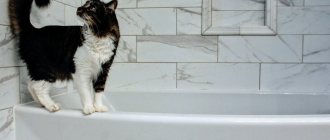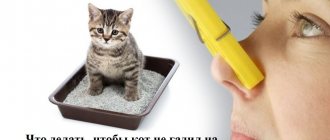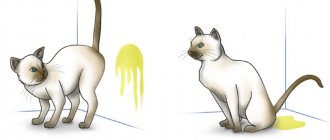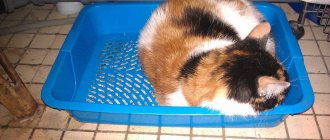Litter in a cat litter box is basic hygiene, allowing you to avoid unpleasant odors, simplify cleaning the litter box, and help your cat go only to the right place. Granules of a good filler “lock” the smell inside themselves, adsorb it and prevent bacteria from multiplying too quickly. In addition, cats are naturally supposed to do their business in the ground, so a tray without filler seems less attractive to them. However, sometimes situations arise in life when you have to refuse the filler.
How to use a cat litter box with mesh and litter?
The use of a tray with a grid and filler and one without a grid varies significantly. Despite the fact that the first type of cat litter is easy to use, not all cat owners understand its principles. To make it comfortable for your pet to use, in addition to choosing the appropriate filler, you need to know where and how much to add, as well as how to remove wet granules.
What filler is best to use?
If the question of why to use a filler has been resolved, you can begin to select it. What material to choose for filling the tray depends on the personal preferences of not only the owner, but also the pet itself. Manufacturers of cat litter with bars do not have any requirements for the litter.
When choosing a material for filling a tray, you need to evaluate its pros and cons. For example, wood pellets are good for everyone, but the packaging with them often contains sharp chips that can injure an animal, mineral pellets do not absorb odors well, generate a lot of dust and, sticking to the pets’ paw pads, spread throughout the house, and silica gel ones are expensive, and what’s more and hiss when in contact with moisture, which not all animals like, some of which refuse to go into a tray filled with this material.
It is impossible to say which filler is better. When choosing it, everyone pursues their own goals. Some cat owners want to save money and use sand or newspaper scraps, others prefer silica gel granules, guided by the principle “cheap things can’t be good.” The material for filling the tray should first of all please the tailed pet. If your small pet likes to put everything in his mouth, it is better to choose natural and biodegradable granules.
Where and how much to pour?
Not all cat owners know how to properly pour litter into a mesh tray. This should be done as follows:
- Remove the grate.
- Fill the tray with granules. The amount of filler depends on its type. If, for example, wood material is used to fill the tray with it, it must be taken into account that when wet it increases significantly in volume. There must be a certain distance between the surface of the granule layer and the grid so that moisture goes into it and does not remain on the grid.
- Return the mesh to its place.
It is difficult to say how much filler will be needed to fill the tray. Its quantity depends on the size of the device, the height of its sides, and the origin of the granules. Approximate height of the filler layer per pet:
- woody – 1–2 cm;
- silica gel – 2 cm;
- mixed – 3 cm;
- sand – 1 cm.
How to clean the tray?
It is important to be able not only to fill the tray, but also to clean it. The frequency of filler replacement depends on its type:
- Wood pellets that crumble when exposed to moisture should be discarded, separating them with a spatula (available with the tray or sold separately) from the remaining ones. If they become completely wet, they must be shaken out of the tray, and then washed with warm water and detergent. This type of litter is changed weekly if only one animal is using the litter box.
- When using silica gel granules, which need to be completely changed every 2 weeks, only feces need to be removed. To ensure quick drying, it is recommended to stir the filler periodically with a spatula.
- If the tray is filled with sand, you need to remove feces and wet lumps after your pet uses the toilet, adding a fresh portion. This material does not absorb unpleasant odors at all, so if this problem is acute, it is better to change it daily.
- The mixed filler must be replaced once a week. After your four-legged pet has visited the toilet, the granules should be sifted with a spatula with holes, and then fresh material should be added.
It is recommended to regularly wipe the floor near the tray with a damp cloth. You should also periodically give it a thorough cleaning, treating it with disinfectants and removing urinary stones.
If you still need to, how can you wean your cat off litter?
The only sure way to wean your cat off litter in the tray, if you decide, is to do it gradually. There is no need to immediately shake everything out and expect that the cat will continue to use the tray without misfires. It is best to reduce the amount of sand every week so that there is less and less of it. As a result, in the last weeks of weaning there will be very little filler at the bottom, which the cat certainly won’t like very much, but she will not fall into a state of shock from the “bald” tray, as if she were offered one right away.
You can also gradually retrain your cat to go into torn newspapers instead of peeing in the litter. From a hygienic point of view, this is a bad decision, and newspapers are not cheap now, but in them the cat will be able to at least slightly realize its natural need to bury its affairs.
In addition, cats really don’t like their paws to be wet, so if there is no litter in the tray, it is better to put a net on it: this way the cat will remain dry when it goes to relieve itself.
Of course, gradual weaning off the filler does not provide a 100% guarantee that the method will work. Perhaps your cat is one of those who is so attached to the litter that she will start going anywhere just to return everything to the way it was.
Reasons for refusing a new filler
1. Too abrupt replacement of the usual contents of the tray with new ones
This usually happens in the first days after the cat arrives in its new home. For various reasons (too expensive, too bad, and so on), the new owner decides to immediately replace the filler. However, cats are conservatives, and any change in usual conditions leads to stress for the animal. And then everything changed: the house, the owner, there was a separation from the mother - if you acquired a baby... At first, you need to organize the usual conditions for the pet - as far as possible. In any case, it is not at all difficult to purchase exactly the same food and litter for the tray.
How is this issue resolved and is it being resolved? In fact, this is not at all difficult - even if the filler you choose is significantly different from the previous one, it will take time. Actually, you can try to offer a new member of the household a different filler - after he gets used to your home. Sometimes the cat does not pay attention to the substitution. But if the contents of the tray caused her confusion and anxiety, do not insist. Start gradually, literally a couple of tablespoons at a time, adding new filler to the old filler. Act according to the circumstances - if the pet calmly uses the tray, the “portions” for replacement can be increased each time. In most cases, the replacement takes place quickly and without “complications”.
If, with an increase in the proportion of the new filler, the animal shows more and more anxiety, the product is not suitable. Go back to old content or look for a new brand. This article will help you make your choice: types of cat litter.
2. Repels odor
The choice of litter for cats is extremely large, and many manufacturers produce products with a variety of additives - mainly for the convenience of owners. Flavorings are a common component in fillers, and it is precisely this that, despite all the other advantages of the product, that the cat may not like. By the way, additives can cause allergies.
3. Don't like the structure
Some cats don't like the crunch of silica gel granules. The animal may also not like the filler in the form of rather large granules - it is noticeably different from the soil that is natural for cats. For him, these are stones that make digging difficult. Conversely, you may not like a filler that is too fine - because it generates a lot of dust.
And it happens that you just like the structure of the filler, but not in the way the owners would like. The pet can happily chew the contents or create a “nest” in the tray.
4. Inappropriate place
It is better to decide on a place for toilet matters immediately, once and for all. If, along with changing the filler, you also decide to move the tray itself, the cat’s confusion is quite understandable.
5. Inconvenient tray
The same as the previous point, but from a different perspective. Having decided to replace the filler, you also purchased a new, unsuccessful tray for your pet.
6. It's a coincidence
And this happens. Perhaps the animal did not pay attention to the unusual mass in the tray. The real reason is that the pet is sick or stressed. If you notice any signs of illness in your pet: loss of appetite, problems with bowel movements, inactivity, nervousness, and so on, do not hesitate to show him to the veterinarian.
At what age does training begin?
The right recommendations will help speed up the long process. Kittens are also children, so there is no certain age for litter box training to be easy and quick. You can force an animal to go potty at 2 months or after 3 months - it depends on its intelligence and learning ability.
If a baby lives with a mother cat, he copies her behavior. The two-month-old kitten is already coping with the task on his own. If the mother is not nearby, the owner can train the cat to use the litter box.
It is not difficult to train a kitten to use the toilet in an apartment, especially when there is a cat nearby, even at 1 month, if the pet is smart. It’s not too late to do this even at 3 months.
What should you pay attention to when choosing a tray with a grid?
When choosing a tray with a grid, it is recommended to pay attention to:
- The material from which the device is made. Plastic should not emit a strong odor. Don’t be shy to smell the product in the store, because the health of your pet and the rest of the home’s inhabitants is at stake. In addition, the plastic must be durable, otherwise the structure will quickly become unusable, breaking or bending under the weight of the animal.
- Grate height. Grids come in high and low. The first option is most preferable, since it allows you to pour more granules into the tray.
- The height of the sides. Trays come with high and low sides. Choosing the first option will allow you to avoid problems such as animals, especially older ones, flooding the walls of the device, the floor and nearby objects.
- Tray size. It must match the dimensions of the four-legged pet.
Toilet training
If home conditions do not allow for space for a litter box, you can train your cat to use the toilet in a different way. The process will take a long time: it will take 1-2 months. To accustom a kitten to the toilet, the tray is carried to it and raised little by little.
When the devices are at the same level, do this:
- the tray is placed on the lowered lid of the plumbing for 5-6 days;
- pour a little litter into the toilet and place the kitten on it;
- To prevent the animal from being scared, you can buy a special attachment.
Litter training a kitten is an important element of upbringing. You can’t do without this skill in an apartment. The owner will need to show will and perseverance. A Persian, a handsome British cat or a cat without a pedigree will learn everything if you don’t hit the baby or yell at him.
Possible reasons
There are many factors, including psychological ones, that influence people to start shitting in the most inappropriate places, such as under the door, in flowers, on upholstered furniture, or even next to the litter box.
Stress
A stressful situation is a serious problem for any pet. In this way, they express a reaction to changes in their usual lifestyle, fear of a person, or even a change in family composition. A puddle can result from an animal's jealousy when the owner pays more attention to another animal, a child, rather than him. Stress can arise when moving to a new home, from rough treatment, if she is pestered by children.
The cat is stressed.
Health problems
A particularly common reason for a cat to start pooping is problems with its health. Such phenomena occur with urolithiasis and kidney pathologies. The cat begins to suffer from pain during urination and associates it with the litter box, which leads to the fact that it begins to avoid it, choosing other places for the toilet. This place often becomes a bed or sofa. Cats with intestinal diseases also shit.
Hormonal disbalance
Hormonal disruption occurs during estrus, pregnancy, and others. These substances affect the psyche and behavior of the animal. In this case, the cat may demonstrate inappropriate behavior from a human point of view. As a result, the pet may shit on the bed, linen or other inappropriate places.
The tray is dirty or inaccessible
A cat can do such an act because the door to the toilet is closed and the animal physically cannot get to it. That is why she has no other choice but to shit in the wrong place. Some breeds are known for their cleanliness and simply cannot afford to go into a litter box where there is already dirt.
Replacement of filler or lack thereof
The cat gets used to one litter, especially if it is used for a long time. The cat develops a strong association with this particular filler. Replacing it with another, even better one from a human point of view, is stressful for the animal; the animal may experience some discomfort, stress, and inconvenience. Thus, the cat begins to look for other places for its toilet.
Physiological factors
Cats need calcium to maintain teeth and bone tissue. It usually enters the body with food. However, if it is of poor quality, the animal will begin to look for something to replace or supplement the food with. In this way, the cat tries to compensate for the mineral deficiency. How to fix the situation :
- Take the animal to a veterinarian who will prescribe vitamin complexes.
- Certain foods are excluded from the cat's diet or replaced with new ones that contain essential minerals.
© shutterstock
You cannot purchase vitamin complexes or medications for your cat on your own. Sometimes hypercalcemia and other complications occur. The animal may have some features that the owner does not know about, since he has not encountered this before. For example, intolerance to certain components, allergies, etc.
The second physiological reason why a kitten eats litter is to grind down its teeth. Despite domestication, a predator still “lives” in pets. Cats themselves try to take care of their teeth and claws by grinding them down on a hard surface. This is exactly the texture that fillers have.
There are two ways to deal with this:
- Feed your cat bones periodically. You need to choose solid ones or give tendons. They are sold in any pet stores. Cats also love to chew on pork or beef ribs, but chicken bones should not be given to animals.
- Buy calcite for your pet. This is a special stone. The cat will not be able to chew it completely, and the teeth are sharpened well.
If the animal has other options, it will not use toilet pellets for other purposes.
We teach a kitten from scratch to go to the litter box without litter
If you are thinking of immediately accustoming your kitten to a litter box without litter, then first of all, be patient. You cannot hit your pet, this will only ruin his psyche and cause rejection of the training process itself. In addition, cats are quite smart animals and oral instruction will be enough (of course, they will not understand speech, but they will understand intonations). You can cover all your favorite areas with oilcloth paper to avoid problems if your cat gets used to going where it shouldn’t.
Tip #1. Drag the tray to the desired location
If the kitten has chosen a certain place, then it is better to move the tray there. Then you need to gradually move the potty to the required corner and room, moving the toilet every day 10 cm closer to the point where it should be located according to plan.
How to stop a cat from chewing wires
How to stop a kitten from peeing on the bed
Action plan for weaning a cat from climbing into a flower pot
Tip #2. Praise and Progression
It is necessary to divide the entire apartment into certain zones according to the degree of distance from the place where the tray is located and the points where the animal defecates. Let's say there are 5 such areas. You also need to distribute your attitude (praise, neutrality, punishment) into three zones. Then gradually move your attitude, as shown in the figure below.
That is, at first you scold the kitten for defecating in the living room, but be neutral if he defecates in the corridor on the way out of the room. Then you begin to scold him not only for feces in the room, but also for crossing, leaving him only a place in the bathroom. And in the end you begin to scold for defecation in any place other than the tray. Relationships are highlighted in colors: red - punishment, yellow - neutrality, green - praise.
Tip #3. Lock it in a separate room
Set up a prison for the animal. Lock him in his room for a week. Place plates with food and water in one corner, and a pot in the other. The tray must be changed several times a day. You will be left with no choice - either the pet will defecate wherever it wants and suffer from the smell, or it will learn to use the toilet. Of course, you must first remove all carpets, as well as upholstered furniture: sofas, armchairs, beds. It is also advisable to remove flowers and any potted plants.
Tip #4. Monitor and carry the cat when it urges
This method will require attention from the owner. Its essence is that you need to guess the moments when the pet goes to the toilet. And when the urge arises, transfer it to the tray. If everything goes well and the kitten goes into the litter box, then you will need to praise him and give him a treat. The disadvantage of this method is that cats can go to the toilet at night, so the owner will still not be able to track all the moments of defecation.
Tip #5. Use of aerosols
When you can’t train your pet, you need to use special aerosols:
- "Antigadin." A low-cost Russian product that does not stain and has a natural composition. But the possibility of allergies cannot be ruled out. However, some people note the lack of effectiveness, short shelf life, and the smell of dichlorvos, which is strong enough to repel not only cats, but also people.
- "Smart Spray" Domestic product based on natural ingredients. You need to spray the tray with this spray, after which the cat should become interested in the aroma and start going to this place. Absolutely all users note a terrible smell from the aerosol, so it is better not to approach the tray after use. About a third of clients indicate the low effectiveness of the product.
- "Stop spray." The spray is produced in the Netherlands and does not cause allergies. Its task is to scare the animal away from the places where it is accustomed to defecate with an unpleasant odor. This is one of the few products that has an attractive aroma for humans, but an unbearable odor for animals. The product holds well, but is easily overwhelmed by other odors, so about a third of customers indicated low effectiveness.
All these aerosols must be used over a long period of time to achieve results. Moreover, after you stop using aerosols, your pet can begin to defecate in any place convenient for him.
How to stop a cat from yelling
How to train a cat
How to stop a kitten and an adult cat from shitting in flower pots
The main thing here is a calm attitude towards the learning process. You should not hit or seriously punish your pet, this can scare away and slow down the development of the skill. First you need to choose a suitable tray. You need to gradually get used to using a tray without filler.
Now consider the following question: what to do if a cat scatters litter?
Our beloved pets inherited this habit, again, from their ancestors. Owners often complain that their cats spend almost hours digging in litter trays and then spread the litter throughout the house.
To cope with this situation, you can simply buy a tray with a high side or purchase a house tray.
Tray houses are closed on all sides and only the entrance for the animal remains open.
Another way out of this situation may be to change the position of the tray grid. To do this, you need to move it from under the filler to the top, placing it on the filler.
Perhaps not every cat will appreciate such an innovation, but many cats tolerate such changes quite calmly. Try it and see for yourself. It is possible that the cat will experience some discomfort for some time, but if she continues to relieve her needs in the tray, then there is no doubt that she will soon get used to it and will go to the tray just as before.
How to teach a cat to order and behave correctly?
In this case, the most important thing is not to scold the cat for digging into the litter. If this is done, she may completely lose the desire to go to the litter box and begin to shit all over the house, which can hardly be called a way out of the situation. Don't forget that when a cat digs in the litter box, she perceives it as an important and worthy task. Therefore, it is better to create an obstacle or do any of the other methods described above to solve the problem than to scold or, worse, beat the animal.
If you find an error, please select a piece of text and press Ctrl+Enter.
Source
Which tray to choose
At first, your kitten will need a litter box with low sides so that he can get in easily. The container should be large enough for the animal to feel comfortable there and be able to use it more than once. If at the time the kitten appears in the house you have not yet managed to purchase a toilet for it, then an old baking dish or any other box may be perfect for this purpose.
There are many varieties of indoor cat litter boxes on the market today, which not every animal wants to use. Experts advise using open trays first. In this case, during the period of accustoming the kitten to it, it will be easier for you to monitor it. Once he gets into the habit of using the litter box, you can place a closed one next to the open container to learn about his preferences. Some animals prefer the privacy of a closed box, while others do not like confined spaces.
Paralympian Talay without arms and legs: “the harder the struggle, the greater the victory”
The newlyweds traveled all over the world and took wedding photos in every country
A broken nail is no problem: tips for treating nails at home
If you have several cats, it is best to have one litter box for each of them, plus one extra. In a multi-story building, place a container on each level.
Brush and vacuum cleaner
If you use regular wood filler, then you know very well: there is always garbage and sawdust near the tray. As they say, remove it, don’t remove it, the result is the same. We suggest buying a small brush and placing it in close proximity to the tray. And then develop a unique algorithm: pass by, sweep up and put away. Alternatively, it makes sense to invest in a small portable vacuum cleaner so that you always have it with you. You will develop the habit of removing sawdust as it appears - and the whole house will immediately become cleaner.
Using a tray without filler: pros, cons, care rules
This design allows you to pour filler into the tray or do without it. When deciding not to use granules to fill the tray, you need to weigh the pros and cons. The advantages of this approach to arranging a cat litter box:
- Saving money on the purchase of filler.
- There is no need to clean up pellets scattered on the floor by your pet when trying to bury feces and urine. Another common problem does not arise - filler particles do not stick to the animal’s paws and fur and are not spread throughout the home.
- No risk of a curious little pet eating the pellets. Their entry into the kitten’s body is fraught with many serious and sometimes dangerous consequences: blockage of the intestines, damage to its walls by a foreign body, diseases of the digestive system.
- Keeping the home and cat clean. Some litters generate a lot of dust, contaminating the living space, paws and fur of the animal.
- There is no risk of the inhabitants of the home developing allergies and getting granules into the respiratory tract or being swallowed by a small child who gets to the cat's litter box.
Some cat owners refuse litter because their tailed pets for some reason do not want to interact with it. At best, this manifests itself in the fact that they do not bury feces; at worst, they ignore the tray, preferring to empty their bowels and bladder in the wrong places.
Disadvantages of using a tray without filler:
- The inability for an animal to realize its natural instinct. Some cats, deprived of the opportunity to bury feces and urine, begin to shit in places not intended for this.
- High risk of the smell of urine and feces spreading throughout the home. One of the main tasks of the filler is to absorb liquid excrement and urine, which significantly reduces the severity of the unpleasant odor.
- The need to clean the litter box immediately after your pet visits it, which is not always possible, especially for working people.
- Contamination of the animal's paws with urine and feces and spreading of their particles throughout the house.
Caring for this device is simple, but requires more time and effort than cleaning a litter tray. It is necessary to wash your pet's toilet with a grate after each use, and it does not matter whether the cat went into it in a small way or in a big way. Daily cleaning involves rinsing the structure with warm water, general cleaning involves soaking and using detergent and a special composition to eliminate the smell of cat urine.
Cat bites and scratches when petted
Many cat owners are familiar with this habit: the cat sits calmly on his lap, the owner strokes it, it purrs and suddenly, for no reason, begins to scratch and bite.
What is the reason for a cat's aggressiveness?
Experts explain this behavior of our pets as follows: cats, on the one hand, love affection and strive to receive it, and on the other hand, they are afraid of affection. The centuries-old experience of their ancestors tells them that such actions on the part of humans can pose a danger. For this reason, cats, up to a certain point, simply “tolerate” their master’s caresses and may even receive a certain pleasure from them, but when their anxiety reaches a certain limit, they already see the caresses as a danger rather than its opposite, and then bites and claw work follow.
Often, the owner then sees the following picture: the cat behaves nervously, is clearly excited and licks itself with signs of obvious imbalance in its movements.
Dealing with this behavior is quite simple: do not forcefully pick up the cat. It is better to wait until the cat comes into your arms on its own. And during stroking, you should carefully monitor the animal’s condition and under no circumstances “stroking” the pet. To understand that a cat is starting to get nervous, you don’t need to be very observant. When she loses peace, it becomes immediately noticeable by the fact that the cat loses relaxation - its body groups and becomes rigid. If the cat begins to swing its tail, purse its ears and tensely follow the movements of its owner’s hands, then you can be sure that its patience has reached a critical point. And if such actions on her part were noticed, then you should stop stroking, and slowly remove your hands and, without touching the cat, carefully stand up. Then the cat will instinctively jump off its lap and there will be no conflict.
Where to place the tray
The litter box in the house should be in a secluded but easily accessible place. Avoid placing the container in tight spaces such as in or under cabinets. Make sure that there are no household appliances near the litter box that make loud noises that could frighten the kitten.
When toothpaste is harmful to children: permissible age doses
The star of the series “Sultan of My Heart” spoke about the choice of his future wife
Sometimes we wear a bra incorrectly: ways that are harmful to health
The litter box should not be placed near your pet's food or drink or in areas where he likes to rest. Always try to keep the tray properly clean so that any unforeseen incidents do not happen. If the container is dirty, the animal may well relieve itself elsewhere. If this does happen, immediately clean up after the kitten and wash the floor in this area to remove all odors.
A clean, odor-free litter box is much more attractive to cats and kittens. If it is not washed, this may well provoke animals to urinate nearby on the rug or anywhere else.
The process of training a kitten to the tray
Be patient to finish what you start.
Important: Light massage stimulates digestion and the bowel movement reflex; When you sit the kitten on the potty, you can stroke its tummy.
Stage one - getting to know each other
For the first time, they put the kitten in the tray several times, take his paw and help him “dig.” Let the baby not be afraid to sniff the pot and the filler: this way he will get used to the place.
Stage two – observation and assistance
It is possible that you will have to run after the kitten throughout the apartment and watch when it starts meowing loudly, squatting, spinning in one place and scratching its paw on the floor.
Then you need to immediately carry him to the tray and not let him go until he goes to the toilet.
It will not be possible to correct the situation in 1 day, but if everything is done correctly, the cat will definitely get used to it.
Stage three - strengthening the reflex
Now the kitten can be scolded for ignoring the toilet. But not too much. When cleaning up after your baby, you just need to throw everything in the litter tray and take the kitten there when he starts looking for a place to go to the toilet. This must be done without shouting.
Additional tips and tricks
- You cannot hit a kitten or poke its face into the dirt;
- the optimal layer of filler in the tray is 5 cm;
- if the breeder’s baby was constantly lying on moisture-absorbing diapers, you will have to be patient;
- The kitten should also be praised for small progress.
Common Mistakes
- Wrong size of granules: the smaller the kitten, the smaller they should be;
- too early or late litter box training;
- If the baby relieves himself on soft surfaces, you need to put a piece of cloth in the filler.
Which filler to use
The type of litter you choose for your litter box may determine how quickly your kitten learns to use her litter box. Today, pet stores offer you many types. These can be fillers based on clay, natural minerals, zeolites, etc. All of them belong to two types: clumping and absorbent. It is best to use unscented litter so as not to overwhelm your kitten's sense of smell.
Since all babies are, as a rule, very curious, they will definitely begin to taste everything. The contents of their trays will be no exception. This can lead to dangerous gastrointestinal problems. For this reason, your best bet is to choose corn or wheat based litters.
Only on a soft spot: Russian Domostroy forbade punishing children in any other way
Smooth armpits without shaving: ways to remove hair using conventional products
25 children of a childless man: an extraordinary reunion
It would be better to lay some kind of rug next to the container so that particles of litter from the kitten’s paws remain on it when it comes out of the tray.
What are the dangers of eating pellets?
Most manufacturers do not add any toxic substances to their raw materials. However, eating pellets from a litter tray is not the healthiest activity for a pet of any age. Particles of the mixture stick to the roof of the mouth and the cat's tongue, forming viscous lumps that are very difficult to spit out. This can lead to constipation or suffocation.
Silica gel granules can cause particular harm to health. They have good absorbent properties, and they swell greatly once they are in the animal's stomach. Their presence causes discomfort and can further lead to serious problems in the gastrointestinal tract. The most dangerous consequences are intestinal obstruction or severe poisoning.
Which cats shit most often?
The most basic reasons why a cat may pee on the sofa or carpets are:
- Dirty tray. According to its instincts, a cat hides its smells. For them, the cleanliness of the toilet and litter is extremely important. If the cat is faced with the problem that the place is "crowded", the animal will look for a new place.
- I don't like the tray. The cat may not like the toilet itself, for example, its shape, depth, or quality of the filler. Thus, the pet is looking for a new suitable place for this.
- Moving the tray to a new location. For some individuals, even moving the tray a few centimeters is critical. The pet gets used to going to the same place.
- No access. A person or the animal itself can close the door to the toilet, thereby blocking access to it.
It is important to choose the right place to place the tray. The pet should feel comfortable, safe, protected
This is why the cat shits on the bed.
Little kittens
Young kittens do not yet have established habits regarding their toilet. The baby can wet the owner's bed, as it can remind him of the sensations of softness, coziness, and comfort. It is necessary for the small pet to get used to its filler as quickly as possible and stop committing such sabotage.
Question to an expert How to help a kitten master the litter box faster? To speed up learning, it is important to place the kitten in the litter box after each meal. The physiology of furry babies is designed in such a way that they usually relieve themselves after eating
Some kittens will only need a few of these lessons, others may need more time. But in general, litter box training at an early age is easy.
Unsterilized animals
The behavior, character, habits of an animal depend on hormonal levels. During heat, cats can change greatly. Attracting the opposite sex occurs using special means. If an animal has been sterilized or castrated, such phenomena are not observed in the animal, which means the animal ceases to experience such needs. After sterilization, it stops marking its territory, as it does not feel the need for mating.
Elderly animals
This behavior is often demonstrated by older individuals. The age of the animal is one of the main reasons why a cat began to shit. Your pet may become incontinent. It makes no sense to scold or punish such an animal. Such measures will not bring any positive effect, but rather, on the contrary, will destroy the trusting contact between the pet and the person. The cat will begin to look for secluded places to relieve its needs.
Gradually, an adult pet will begin to demonstrate the behavior of a small kitten, both in its behavior and in its level of intellectual development. If the veterinarian cannot help with treatment, the best solution in this case will be special diapers for animals.
The cat scatters litter. What to do?
Experienced cat lovers immediately understood what we were talking about. A well-known, painful problem: traces of litter extend far beyond the tray where the pet goes for urgent matters. Wood dust is everywhere: in the kitchen, carpets, clothes, even in bed. From a logical point of view, everything is understandable: the furry pet will do its business, dig heartily in the tray, throwing out a trail of sawdust and husks. Some part settles on the animal’s paws, then quietly spreads throughout the house or apartment. Is it a vicious circle?











